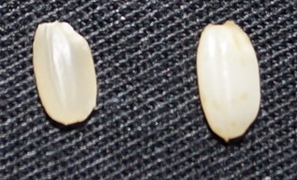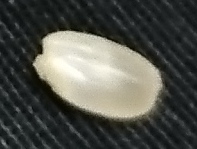Plant species have the power (abscisic acid) to interfere with the functions of enzymes. When germinated in water, its enzyme inhibitory effect is released. If you do not put it in water, it may become mineral deficient (iron deficiency anemia, etc.) because it interferes with the nutrient absorption of other foods due to enzyme inhibiting action; please let the brown rice germinate before you cook.
Once the rice germinates, do not allow it to dry up. Once the rice dries up, its enzyme inhibitory action returns so it is suggested that you cook the germinated rice right after germination. If possible, avoid buying germinated brown rice available in the market because there is a big chance that the rice dries up after germination. Moreover, data show that the enzyme inhibiting action of rice is not removed thoroughly if soaked in water at low temperature. It is advisable that the water used in soaking the brown rice is at room temperature.
★ Germination Method
1. Wash the rice thoroughly.
2. Put the brown rice in a container with a lid to avoid entrance of dust or insects. Do not seal up the container.
3. Leave some water into the container with the brown rice. Leave it at room temperature.
The brown rice will start to germinate in 24 hours at room temperature. If the room temperature is high, the water will be smeared quickly. Change the water in the container when it happens. When replacing the water, leave about 10% of the water and add it to the soaking water so that germination is quicker. Finally, replace the water before cooking the rice.
*Some people may keep the water used for soaking in the refrigerator for future use.
*If it is troublesome for you to change the water in the container from time to time, you may do the easy way. First, wash the brown rice and put it in the rice cooker. Then, set the rice cooker to start cooking automatically for the next day.


Check the germination of the rice with your naked eyes. Make sure that the rice never dries up (runs out of water) after germination.
Note: If you see some rice grains floating in the water, let them sink immediately because if left floating for a long time, they will be moldy.
Note: After putting the brown rice in the water, some bubbles may appear and the water becomes white and cloudy. Please change the water if it smells.
Note: Use purified water for soaking.
Note: If the temperature is too high or the rice is soaked for a long time, the water becomes smeared and it smells. If it is not an unpleasant smell like other fermented food you may cook the rice but it may not be delicious. If it smells bad, that means the rice is spoiled. It is better to cook within 24 hours if the temperature is high. It is better to change the water once in 24 hours. Then change the water before you cook the rice.
Note: If you cook brown rice alone and keep it warm in the rice cooker for more than a day, the rice may have undesirable smell so it is suggested to cook it with Azuki or other beans.
Note: If you put the rice in a fridge, try not to use a microwave when reheating the rice. Reheating your food with a microwave oven not only destroys the nutrition of foods, but it also generates a large amount of active oxygen in the body. Active oxygen is very harmful to the body because it does not only speed up the aging process but also cause many diseases such as arteriosclerosis, cancer, and etc. You may instead use a rice cooker set on keep warm function or use a steam in a pan.
☆ If you cook brown rice and Azuki or other beans together, you will come up with tasty and aromatic rice. If you don’t have Azuki, you may use other grains such as green peas; soy beans, black or red rice, and etc. Cook them together. The taste becomes more delicious as it keeps warm for a long time after cooking.
☆ For each ¾ c (180 milliliter) of brown rice, include 1.5 tsp (7 grams) of Azuki grains for excellent result. Azuki is a seed so it needs water for it to release its enzyme inhibiting action.
Recommended Proportion/ Volume
If you cook ¾ c (180 milliliter) of brown rice, add 210-270 ml of water.
The proportion of brown rice
☆¾ c (180 milliliter) of brown rice (approx. 147 g) with 1.5 tsp (7 g) of red beans, 1 g of salt and Nigari. Nigari contains a lot of useful minerals. Nigari is the byproduct of salt production from seawater. Nigari is the liquid that remains after salt crystallizes. It contains various minerals. The main component is magnesium.
How to Cook Germinated Brown Rice
You may use a rice cooker or a pressure cooker in cooking the brown rice. If rice cooker is too small or not available, you may use an ordinary pot.
If you cook in an ordinary pot, use a large pot if possible. Let the water boil until it produces steam. When the steam starts, set the fire into medium heat for about 20 minutes and then turn off the fire then wrap the entire pot with a blanket or cloth and leave it for 1 to 2 hours.
If you cook the rice with a pressure cooker, just leave the lid on top of the pot. Do not tighten the lid so that the rice will cook slowly and the temperature is not too high.
★ How to keep the germinated brown rice in a rice cooker
When cooking is done, leave the brown rice in the rice cooker. Set the rice cooker to keep warm mode. Using a ladle, flip the rice over once a day. You may start eating immediately, but after 3 days it will be more delicious as the rice turns sticky. Fermented brown rice can be kept in a rice cooker for one week in keep warm mode. It will be more convenient for you if you cook a lot of rice at once since it can be kept in the rice cooker for 1 week.
You may keep 2 rice cookers at home. One rice cooker may be used as rice warmer. This is for you to enjoy delicious sticky brown rice every day.


